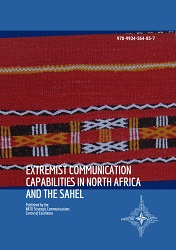Extremist Communication Capabilities in North Africa and the Sahel
Extremist Communication Capabilities in North Africa and the Sahel
Author(s): Andreea Stoian Karadeli
Contributor(s): Tomass Pildegovičs (Editor)
Subject(s): Social Sciences, Communication studies, Sociology, Theory of Communication, Crowd Psychology: Mass phenomena and political interactions, Criminology, Radical sociology
Published by: NATO Strategic Communications Centre of Excellence
Keywords: North Africa; The Sahel; extremist communication capabilities; terrorism; Salafi-jihadi groups; al-Qaeda and ISIS; groups’ multilevel communication; jihadi phenomenon;
Summary/Abstract: The complex nature of the threat of terrorism caused by groups active in North Africa and the Sahel requires effective information to prevent, detect, and eventually investigate all criminal activities related to their areas of interest. In the Maghreb-Sahel region, more than in any other place, the boundary between the two main Salafi-jihadi groups – al-Qaeda and ISIS – is porous at best and non-existent at worst. While borders between these Salafist religious spheres can be hard to define, they are tangled with contextual and interest-based factors, thereby transforming the regional jihadi ecosystem into a challenging mosaic. The main aim of this research is to map the communication capabilities of terrorist groups in North Africa and the Sahel, taking into consideration the local context as well as to identify and categorise the specific means used to disseminate propaganda in each country / region by contextualising the material produced in / for / about African Jihadism by both al-Qaeda and ISIS groups. Bearing in mind that terrorism functions as a communicative act, the groups’ multilevel communication capabilities are a core element of the jihadi phenomenon in North Africa and the Sahel.
- Print-ISBN-13: 978-9934-564-85-7
- Page Count: 40
- Publication Year: 2020
- Language: English
- eBook-PDF
- Table of Content
- Introduction

